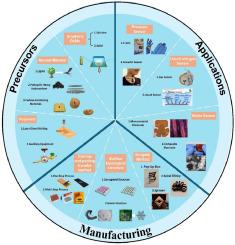使用激光诱导三维多孔石墨烯的柔性/可拉伸传感器的最新进展:从前驱体到制造
IF 8.3
2区 材料科学
Q1 MATERIALS SCIENCE, MULTIDISCIPLINARY
引用次数: 0
摘要
石墨烯是柔性传感器的理想材料,具有出色的拉伸性和延伸性,但现有的多步骤制备方法严重阻碍了石墨烯的进一步发展。激光诱导石墨烯(LIG)是最近兴起的一种技术,可实现无掩膜、快速扫描和高空间分辨率的工业规模制备。本综述从前驱体选择到制造方法的角度,介绍了三维多孔石墨烯的最新进展。首先,结合辅助加工设备对氧化石墨烯、聚合物、光热/化学转化天然材料等常用前驱体进行了分类。然后,总结了基于 LIG 的传感器的三种通用制造策略,包括浇铸-剥离转移、拓扑结构和 Kirigami 设计。接着,根据传感原理对基于 LIG 的柔性/可拉伸压力、应变、液体和气体传感器的代表性进展进行了分类,旨在提高实际应用中的传感性能。最后,讨论了 LIG 制造和集成柔性传感器的最新发展、主要挑战和前景,展示了未来可穿戴电子产品的巨大潜力。本文章由计算机程序翻译,如有差异,请以英文原文为准。

Recent advances in flexible/stretchable sensors using laser-induced three-dimensional porous graphene: From precursor to manufacturing
Graphene is an ideal material for flexible sensors with outstanding stretchability and extensibility, but its further development is being severely hindered by the existing multi-step routes. Laser-induced graphene (LIG) is a recently emerging technology that enables industrial scale preparation with mask-free, fast-scanning speed, and high spatial resolution. In this review, the latest advances on three-dimensional porous LIG from the perspective of precursor selections to manufacturing methods are presented. First, the commonly precursors such as graphene oxide, polymers, and natural materials for photothermal/chemical transformation was classified in combined with auxiliary processing equipment. Then, three all-purpose fabrication strategies, including casting-and-peeling transfer, topology architecture and Kirigami design, are summarized for the LIG-based sensors. Next, the representative progress of flexible/stretchable LIG-based pressure, strain, liquid, and gas sensors were categorized based on sensing principles, with the aim of improving the sensing performance in practical applications. Finally, the newest developments, major challenges, and outlook in LIG-manufacturing and integrated flexible sensors are discussed, showing huge potential in future wearable electronics.
求助全文
通过发布文献求助,成功后即可免费获取论文全文。
去求助
来源期刊

ACS Applied Materials & Interfaces
工程技术-材料科学:综合
CiteScore
16.00
自引率
6.30%
发文量
4978
审稿时长
1.8 months
期刊介绍:
ACS Applied Materials & Interfaces is a leading interdisciplinary journal that brings together chemists, engineers, physicists, and biologists to explore the development and utilization of newly-discovered materials and interfacial processes for specific applications. Our journal has experienced remarkable growth since its establishment in 2009, both in terms of the number of articles published and the impact of the research showcased. We are proud to foster a truly global community, with the majority of published articles originating from outside the United States, reflecting the rapid growth of applied research worldwide.
 求助内容:
求助内容: 应助结果提醒方式:
应助结果提醒方式:


